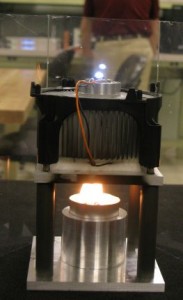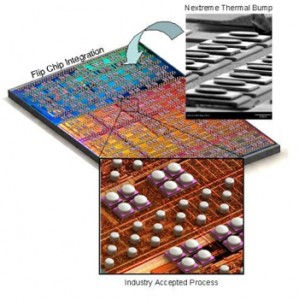Jan
8
The Nuisance of Heat Answered By Thermoelectric Converters
January 8, 2009 | 7 Comments
Tetsuo Nozawa of Nikkei Electronics saw a demonstration of thermoelectric conversion while interviewing people at Nextreme Thermal Solutions, Inc. in the US. In the rig a candle is used to heat a thermoelectric converter.
What might be a surprise is that the process of burning the candle -> on to heating the thermoelectric converter -> powering an LED creates more lumens than the candle itself.
Mr. Mozawa’s photo shows the rig is superbly simple, just a paraffin candle under the converter wired to the LED. The little demonstration makes clear that lighting with flame is less efficient opposed to using the heat to drive an efficient light emitter. Actually the candle’s light plus the LED’s light more than doubles the gross lumens. Secondary recovery does have a future.
The thermoelectric field is gathering momentum and increasing efficiency. Many manufacturers are attending to this technology, as it requires no moving parts so the durability and miniaturization prospects look quite good.
For many heat producing power generation kits the excess heat is a nuisance, expensive to dispense with and money simply lost into things like rivers, the atmosphere and simply radiated away warming anything nearby which can be even more expense. From huge power installations generating electricity to automobiles thermoelectric on to microelectronics, thermoelectric conversion should find welcoming places. In the U.S. and Europe automakers from GM to BMW express enthusiasm for the technology to add to the electric output and reduce fuel requirements.
In fact is thermoelectric isn’t particularly efficient, but does lend itself to things like automotive as the converters can be modules and durable producers of low voltage output. Why pull an alternator belt if you can get the electricity out of the exhaust or radiator?
Today it doesn’t look likely that thermoelectric will be a major player in electric power plants as cogeneration systems at those scales would be more in line with other technologies. One wonders, with at least half and in many plants as much as three quarters of the energy in the fuel just escapes. The world really could double electrical output for the same fuel cost.
So who are these Nextreme guys? They are a leading micro thermoelectric converter manufacturer. The breakthrough product seems to be the Thermal Copper Pillar Bump (CPB) design that has applications in electronics where the technology can be used to cool and recover heat back into power. A highly desired goal is application in PC data centers where the operating costs for power to cool the electronics exceeds the power to process the data.
How good have they managed to get? A temperature difference of 60ºC has been achieved across the 60 µm (0.06 mm) high Nextreme CPB by running an electrical current through it. The Nextreme CPB demonstrated maximum power pumping capabilities exceeding 150 W/cm2. When subjected to heat the Nextreme CPB has demonstrated the capability to generate up to 10 mW of power per bump.
150 W/cm2 . . . That seems like a lot of power from a differential of 60ºC. Things are coming along faster than I had expected.
Comments
7 Comments so far




Reread that. Peltier junctions move heat, and the module can move (not generate) 150 watts/cm^2.
It generates 10 milliwatts per bump, with no mention of the num ber of bumps/cm^2
^^Correct.
It’s really a nice and helpful piece of information. I’m glad that you shared this helpful info with us. Please keep us informed like this. Thanks for sharing.
Awesome post. I so good to see someone taking the time to share this information
Of course, what a great site and informative posts, I will add backlink – bookmark this site? Regards, Reader
Good! Thank you! I always wanted to write in my site something like that. Can I take part of your post to my blog?
Intriguing post. I have been searching for some good resources for solar panels and discovered your blog. Planning to bookmark this one!